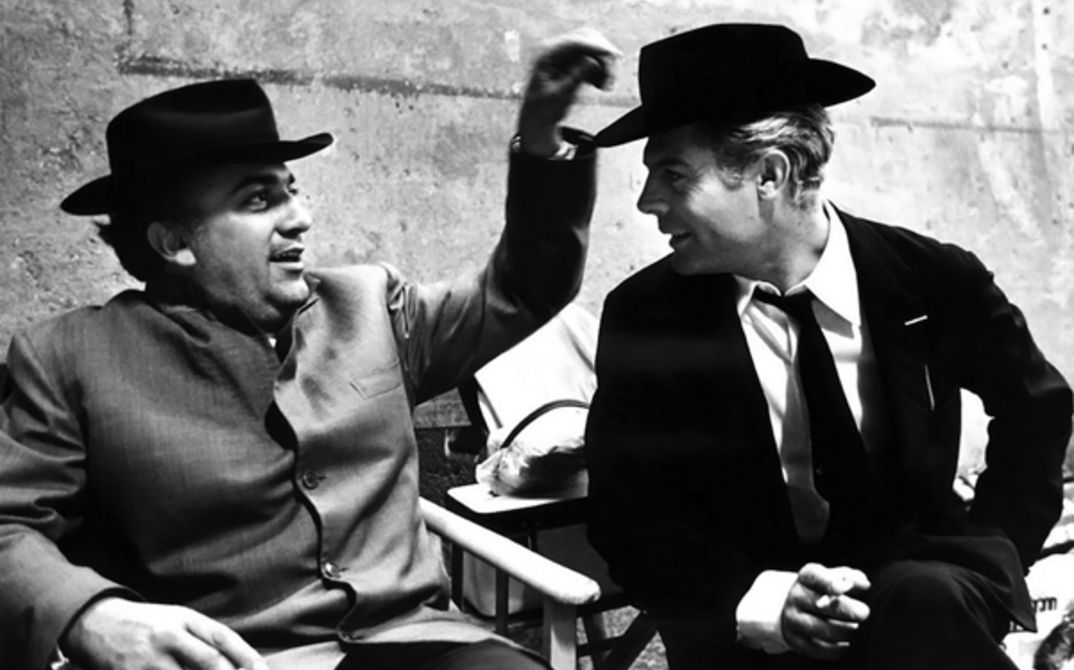OTTO E MEZZO (8½, I/F 1963, 19.1., Introduction: Gerhard Midding & 26.1.) Fellini’s masterpiece is a film about filmmaking and producing images. Before it, he had made 7 1/2 films and this one marked both a turning point in his oeuvre and its pinnacle. It is about director named Guido Anselmi (Marcello Mastroianni), who wants to make a film but does not know what about. He retreats to a steam bath, where he contemplates his suppressed complexes and his childhood dreams and reflects upon the absurdities of the film industry, his relationship with art and with the female sex, finally about the meaning of life. “OTTO E MEZZO was a kind of psychoanalysis session, I could almost call it auto-psychoanalysis because Guido was the portrait of a man of my generation - a sensitive, intelligent man, a very characteristic anti-hero type. He was the prototype of that generation of 40-year-olds, in all their weakness and lack of orientation - a generation of a kind of person that is no longer useful today because today we need people who know exactly what they want.”
LA DOLCE VITA (I/F 1960, 21. & 31.1.) depicts seven days and seven nights in the life of the reporter Marcello Rubini (Marcello Mastroianni), who earns his money working for the tabloid press but fancies himself as a serious writer. Told as a series of episodes, the events - his fiancee’s overdose, an encounter with an American film star (Anita Ekberg), a clearly unreal miracle, a night with millionaire’s daughter Maddalena (Anouk Aimée), his father’s visit, jet-set parties, a friend’s suicide - all testify to an eventful, yet ultimately lonely, life as part of Rome’s high society. The film caused a sensation and a scandal. Conservative MPs in Rome called for it to be banned and the Vatican’s newspaper warned Catholics against going to see it. “La Dolce Vita” soon became a synonym for the high life outside of Italy too, and the word “paparazzo”, which in the film is the name of a news photographer, entered several languages. Mastroianni became world famous with his role as Fellini’s alter ego (“It is an autobiography. I am Marcello, from the skull to sole”).
GINGER E FRED (Ginger and Fred, I/F/FRG 1986, 23. & 29.1.) Amelia (Giulietta Masina), an aging singer and her former partner Pippo (Marcello Mastroianni) are reunited after 30 years for a Christmas TV special. Once again, they perform their version of Ginger Rogers’ and Fred Astaire’s tap dance routine. GINGER E FRED is both a nostalgic swan song and a biting satire of the excesses of private television entertainment. Amelia and Pippo find themselves part of an absurd line up of TV numbers, which includes the maker of edible women’s underwear, a woman who claims to have an alien lover, a former priest who is set to kiss his fiancée in the program, 24 dancing dwarfs and a housewife who talks about the traumatic experience of living without a TV for a month.
INTERVISTA (Interview, Italy 1987, 25.1.) On the 50th anniversary of the existence of the Roman film studio Cinecittà, Federico Fellini paid tribute with a film in a film. Observed by a Japanese film team, he gives an insight into the turbulences and chaos of filmmaking with a poetry that borders on the surreal, involving many of his co-workers from over the years, for example costume designer Danilo Donati, cameraman Tonino Delli Colli, assistant director Maurizio Mein, producer Pietro Notarianni. Marcello Mastroianni and Anita Ekberg were reunited almost 30 years after LA DOLCE VITA.
LA CITTÀ DELLE DONNE (City of Women, I/F 1980, 30.1.) “Planet Fellini in a female universe. This is not only one of the most flamboyant but also one of the most honest undertakings of the director who sees himself as a provincial tourist in the mystery of existence. A film, a dream. Fellini’s alter ego, Snaporaz (Marcello Mastroianni) stumbles with a perplexed smile, through former pleasure gardens, whose residents now unsettle him, now threaten, taunt, ignore, fixate him deridingly or put him on the dock. Steadfastly changing colors and moods, the film sleepwalks from one scene to the next, swaying between confusion and temptation to summon up (and destroy) restlessly all the images with which the patriarchy tries to banish women - soubrette, amazons, feminist, madonna, mama, whore, enigma, goddess of death. In all the film versions of this perception there is an anthology of images and those of making images of oneself.” (Harry Tomicek) (hjf)
With the kind support of the Istituto Italiano di Cultura di Berlino.



